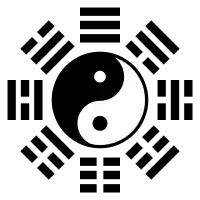Chang'e
Chang'e (/ˈtʃɒŋ.ə/ CHONG-ə; Chinese: 嫦娥; pinyin: Cháng'é), originally known as Heng'e, is the goddess of the Moon and wife of Yi, the great archer. Renowned by her beauty, Chang'e is also known for her ascending to the moon with her Yu Tu, the Moon Rabbit and living in the Moon Palace (广寒宫). She is one of the major goddesses in ancient Chinese mythology. In modern times, Chang'e is the namesake of the Chinese Lunar Exploration Program.
| Chang'e | |||||||||||||||||||||||||||||||||||
|---|---|---|---|---|---|---|---|---|---|---|---|---|---|---|---|---|---|---|---|---|---|---|---|---|---|---|---|---|---|---|---|---|---|---|---|
 Chang'e flies to the moon drawn by Tsukioka Yoshitoshi | |||||||||||||||||||||||||||||||||||
| Chinese | 嫦娥 | ||||||||||||||||||||||||||||||||||
| Literal meaning | Chang the Beautiful | ||||||||||||||||||||||||||||||||||
| |||||||||||||||||||||||||||||||||||
| Heng'e | |||||||||||||||||||||||||||||||||||
| Chinese | 姮娥 | ||||||||||||||||||||||||||||||||||
| Literal meaning | Heng the Beautiful | ||||||||||||||||||||||||||||||||||
| |||||||||||||||||||||||||||||||||||

Origins and Descriptions
Chang'e first appeared in Guicang, a divination text written in Zhou Dynasty (1046 BC - 256 BC). From the few preserved fragments of the text, it mentions "Yi shoots the ten Suns,"[1] and "Chang'e ascending to the moon."[1] Chang'e—originally named Heng'e (姮娥)—was renamed to avoid the taboo on sharing names with a deceased emperor,[2] in this case, Liu Heng, an emperor from Han Dynasty. Many Chinese poems are written around the theme of Chang'e and the moon.
In pre-Qin Dynasty (pre 221 BC), the text, Classic of Mountains and Seas (山海经), mentions "a woman is bathing the moon; she is Chang Xi, the wife of Emperor Jun. She has given birth to twelve moons, and only then does she begin to bathe the moon.[3] (有女子方浴月,帝俊妻常羲生月十二,此始浴之。)" The name "Chang Xi" in this text refers to "Chang'e" since the pronunciation of "e (娥)" is identical to "xi (羲)" in ancient Chinese.[4]
Late Tang Dynasty (618-907), famous poet, Li Shangyin, wrote the poem "Chang'e" based on the story of Chang'e stealing the immortal elixir. Like this goddess, the poet discovers a connection in the solitude of moonlight, sensing their shared loneliness while gazing at the night sky. Among the hundreds of poems around Chang'e and the moon, she gradually evolved into a symbol of nostalgia and solitude[5] for numerous poets beyond Li.
The original poem in Simplified Chinese:
嫦娥
雲母屏風燭影深,長河漸落曉星沉。
嫦娥應悔偷靈藥,碧海青天夜夜心。
The translation by Witter Bynner, in his book The Jade Mountain:
To the Moon Goddess[6]
Now that a candle-shadow stands on the screen of carven marble
And the River of Heaven slants and the morning stars are low,
Are you sorry for having stolen the potion that has set you
Over purple seas and blue skies, to brood through the long nights?
During the Ming and Qing dynasties (Ming: 1368–1644, Qing: 1644–1911), with the flourishing of urban literature, the image of Chang'e gradually became more secularized. In the novel Journey to the West (西游记, 1592), Chang'e is a title that refers to the celestial maidens in the Moon Palace, and it is the Weathervane Marshal who teases the Niche Dress Fairy, not Chang'e. In Strange Stories from a Chinese Studio (聊齋志異, 1766), while Chang'e remains a celestial being from heaven, her character undergoes a transformation as she descends to the mortal realm, shedding her divinity.
Myth
Tales

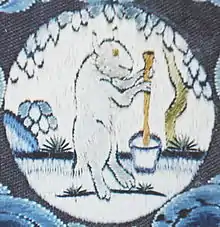
There are many tales about Chang'e, including a well-known story about her that is given as the origin of the Mid-Autumn Festival.[7]
In one version, in a very distant past, Chang'e was a beautiful woman. Ten suns had risen together into the skies and scorched the Earth, thus causing hardship for the people.[7] Hou Yi, a legendary archer and the husband of Chang'e, shot down nine of them, leaving just one Sun, and was rewarded with two portions of the elixir of immortality.[7] As he did not want to gain immortality without his beloved wife, Hou Yi waited to consume the elixir and left it with his wife, Chang'e.[8] However, while Hou Yi went out hunting, his apprentice Fengmeng broke into his house and tried to force Chang'e to give him the elixir, so Chang'e took both portions herself rather than giving them up to Fengmeng. Then, Chang'e flew upward past the heavens, choosing the Moon to be her immortal residence as she loved her husband and wished to live near him.[7] When Hou Yi discovered what transpired, he felt responsible for Chang'e, so he displayed the fruits and cakes that his wife had enjoyed, then killed himself.[7]
In older versions of the story, Chang'e stole the elixir from Hou Yi, drank it, and flew to the Moon so that her husband could not go after her.[9]
In other depictions

Chang'e also appears in Wu Cheng'en's late 16th-century novel, the Journey to the West; here, she is said to live in the Guǎng Hán Gōng (廣寒宮, lit. the "Vast-Cold Palace"), located upon the Moon. During a heavenly festival of immortal peaches (after Sun Wukong's banishment), the heavenly official (a Canopy Marshal named Heavenly Tumbleweed) who would become Zhu Bajie, became heavily drunk, saw the goddess, Chang'e, and attempted to force himself on her, only to be prevented and reported for this act, resulting in him being reincarnated as a boar/man beast-monster, who would later be recruited by the Bodhisattva, Guanyin, as a guardian for Tang Sanzang as he went on his pilgrimage to India for the Tripitaka, the three baskets of scriptures written by Tathāgata Buddha. Later into the story, the goddess, Chang'e's, pet, the Jade Rabbit, became an antagonist and had to be retrieved by Chang'e or-else Sun Wukong would have killed the rabbit.
Space travel
Chang'e was mentioned in a conversation between Houston CAPCOM and the Apollo 11 crew just before the first Moon landing in 1969:
Ronald Evans (CC): Among the large headlines concerning Apollo this morning, is one asking that you watch for a lovely girl with a big rabbit. An ancient legend says the girl named Chang-O has been living there for 4,000 years. It seems she was banished to the Moon because she stole the pill of immortality from her husband. You might also look for her companion, a large Chinese rabbit, who is easy to spot since he is always standing on his hind feet in the shade of a cinnamon tree. The name of the rabbit is not reported.
Michael Collins (CMP): Okay. We'll keep a close eye out for the bunny girl.[note 1]
The International Astronomical Union has assigned the name Chang-Ngo to a small impact crater on the Moon. In 2007, China launched its first lunar probe, a robotic spacecraft named Chang'e 1 in the Goddess' honor. A second robotic probe, named Chang'e 2, was launched in 2010.[10] A third Chang'e spacecraft, called Chang'e 3, landed on the Moon on December 14, 2013, making China the third country to achieve such a feat after the former Soviet Union and the United States. The lander also delivered the robotic rover Yutu ("Jade Rabbit") to the lunar surface. On January 3, 2019, Chang'e 4 touched down on the far side of the Moon and deployed the Yutu-2 rover.[11]
In popular culture

The original plotline and inspiration of Naoko Takeuchi's Sailor Moon is inspired by the legend of Chang'e (and Nayotake-no-Kaguya-hime from The Tale of the Bamboo Cutter and the myth of Selene and her mortal-turned-immortal lover, Endymion from Classical Greco-Roman Mythology). The titular character is a princess of the Moon while her love interest is from Earth; her reincarnation's civilian identity's name is "Usagi Tsukino" (a pun on the "Rabbit on the Moon").
In 2013, Chang'e was released as a playable character in the MOBA Smite.
In 2018, Chang'e was also released as a playable character in Mobile Legends: Bang Bang.
In the video game series Touhou Project, Chang'e is the mysterious sworn enemy of Junko,[12] the final boss of the 15th game Legacy of Lunatic Kingdom.
Chang'e and her story is the main theme of the 2020 American-Chinese animated feature film Over the Moon produced by Netflix. The goddess is voiced by Phillipa Soo.[13]
Chang'e and her story was reimagined in the 2022 fantasy novel Daughter of the Moon Goddess by Sue Lynn Tan.[14]
Gallery
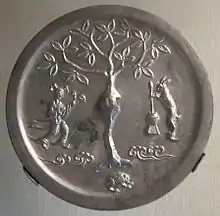 Tang Dynasty Bronze Mirror with Chang'e and Moon rabbit, Honolulu Museum of Art
Tang Dynasty Bronze Mirror with Chang'e and Moon rabbit, Honolulu Museum of Art Porcelain Pillow of Guanghan Palace in Yuan Dynasty, collected in Datong Museum
Porcelain Pillow of Guanghan Palace in Yuan Dynasty, collected in Datong Museum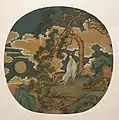 Fan Map of Chang'e in Yuan or Early Ming Dynasty
Fan Map of Chang'e in Yuan or Early Ming Dynasty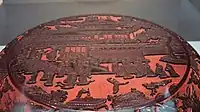 Moon Palace on Ming Dynasty lacquer wooden box
Moon Palace on Ming Dynasty lacquer wooden box Colored Paintings of the Summer Palace Corridor: Guanghan Autumn Scenery, a copy of Qian Hui'an 's imitation of Qing Dynasty painter Hua Yan in the late Qing Dynasty
Colored Paintings of the Summer Palace Corridor: Guanghan Autumn Scenery, a copy of Qian Hui'an 's imitation of Qing Dynasty painter Hua Yan in the late Qing Dynasty Tsukioka Yoshitoshi Ukiyo-e A Hundred Poses of the Moon Chang'e flees to the Moon
Tsukioka Yoshitoshi Ukiyo-e A Hundred Poses of the Moon Chang'e flees to the Moon_(14760951946).jpg.webp) Illustration of Chang'e in "Three Religions in China: Confucianism, Buddhism and Taoism" (1887) of DuBose
Illustration of Chang'e in "Three Religions in China: Confucianism, Buddhism and Taoism" (1887) of DuBose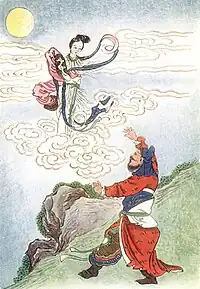 Chang'e flies off into the Moon as her husband Houyi watches
Chang'e flies off into the Moon as her husband Houyi watches
Notes
- NASA transcripts had attributed the response to Aldrin (Apollo 11 Technical Air-to-Ground Voice Transcription. National Aeronautics and Space Administration. Page 179), but corrected NASA transcripts attribute it to Collins (Woods, W. David; MacTaggart, Kenneth D.; O'Brien, Frank. "Day 5: Preparations for Landing". The Apollo 11 Flight Journal. National Aeronautics and Space Administration. Retrieved 26 June 2018.)
References
- Jiahao, Li (April 2013). "Identifying the Wangjiatai Qin (221 B. C. E.-206 B. C. E.) Bamboo Slip "Yi Divinations" (Yi zhan) as the Guicang". Contemporary Chinese Thought. 44 (3): 42–59. doi:10.2753/csp1097-1467440304. ISSN 1097-1467.
- "Forgetting: Chang'e Descends to Earth, or Chang'e Escapes to the Moon". The White Review. Retrieved 2 October 2023.
- Birrell, Anne (1999). Classic of Mountains and Seas. Penguin Classics. ISBN 978-0140447194.
- Shen, Zhongwei (2018). "Zheng-Zhang Shangfang 郑张尚芳 In Memoriam". Journal of Chinese Linguistics. doi:10.1353/jcl.2017.0046. ISSN 2411-3484.
- Li, Xiaotong (2023), "Comparison of Moon Imagery in Chinese and Western", Proceedings of the 2022 4th International Conference on Literature, Art and Human Development (ICLAHD 2022), Paris: Atlantis Press SARL, pp. 357–361, ISBN 978-2-494069-96-1, retrieved 5 October 2023
- Bynner, Witter (1929). The Jade Mountain. Knopf.
- Yang & An 2005, 89-90 & 233.
- "Four Legends Of The Mid Autumn Festival". June 2021.
- Liu An (ed.). 覽冥訓.
羿請不死藥於西王母,姮娥竊以奔月,悵然有喪,無以續之。
{{cite book}}:|work=ignored (help) - Clark, Stephen (1 October 2010). "China's second moon probe dispatched from Earth". Spaceflight Now. Retrieved 1 October 2010.
- Rivers, Matt (3 January 2019). "China lunar rover successfully touches down on far side of the Moon, state media announces". CNN. Retrieved 3 January 2019.
- She has a deep grudge against Chang'e, one of the Lunarians.
- Debruge, Peter (9 October 2020). "'Over the Moon' Review: Netflix Celebrates Chinese Culture With Dazzlingly Designed but Otherwise Conventional Lunar Toon". Variety. Retrieved 19 December 2020.
- "THE INSPIRATION BEHIND DAUGHTER OF THE MOON GODDESS". STARBURST Magazine. Retrieved 29 June 2022.
Bibliography
- Yang, Lihui; An, Deming (2005). Handbook of Chinese mythology. Santa Barbara: ABC-Clio. ISBN 1-57607-806-X.
Further reading
- Allan, Tony, Charles Phillips, and John Chinnery, Land of the Dragon: Chinese Myth, Duncan Baird Publishers, London, 2005 (through Barnes & Noble Books), ISBN 0-7607-7486-2
- Laing, Ellen Johnston, "From Thief to Deity: The Pictorial Record of the Chinese Moon Goddess, Chang E" in Kuhn, Dieter & Stahl, Helga, The Presence of Antiquity: Form and Function of References to Antiquity in the Cultural Centers of Europe and East Asia. Wuerzburg, 2001, pp. 437–54. ISBN 3927943223
External links
 Media related to Chang'e at Wikimedia Commons
Media related to Chang'e at Wikimedia Commons
